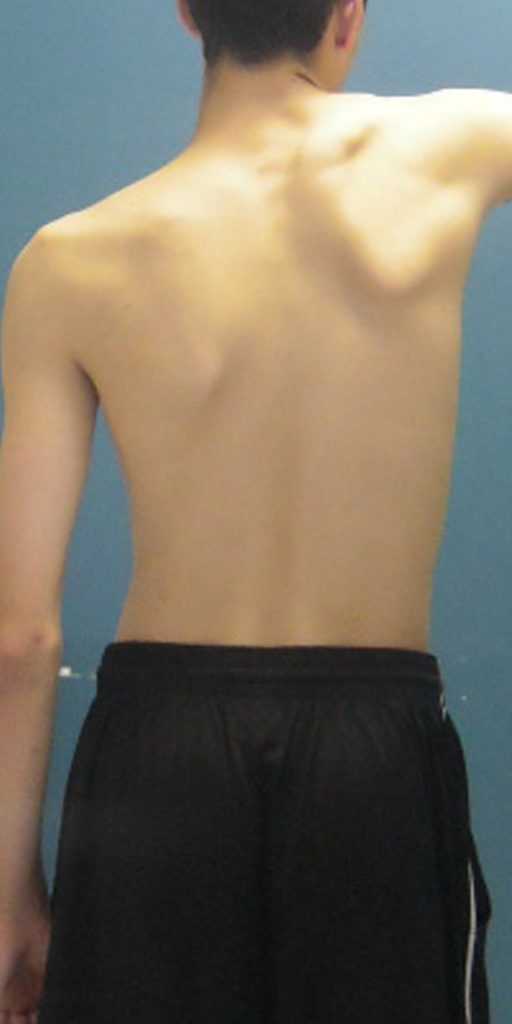This month’s installment of Clinical Pearls comes from Dr. Ben Kibler and Aaron Sciascia from the Shoulder Center of Kentucky. Together they are on the forefront of scapular function and evaluation. Due to the in depth detail of the evaluation process of the scapula, this post will be divided into two parts. I hope you enjoy and be sure to ask questions or leave comments for Dr. Kibler and Aaron to answer.
W. Ben Kibler, MD
Aaron Sciascia, MS, ATC, NASM-PES
Shoulder Center of Kentucky
The scapula has several roles in normal shoulder function. First, the scapula must simultaneously upwardly rotate, posteriorly tilt, and externally rotate to clear the acromion from the moving arm in forward elevation or abduction. Also, the scapula must synchronously internally/externally rotate and posteriorly tilt to maintain the glenoid as a congruent socket for the moving arm and maximize concavity compression and ball and socket kinematics. In order for maximum concavity-compression to occur, the scapula, which is the platform for the rotator cuff muscles, must be dynamically stabilized in a position of relative retraction during arm use. Dynamic muscle function is the major method by which the scapula is stabilized and purposefully moved to accomplish its roles. Muscle activation is coordinated in task specific force couple patterns to allow stabilization of position and control of dynamic coupled motion. The scapula is connected to the axial skeleton and stabilized against it by the strut of the clavicle.
Nerve lesions (spinal accessory, dorsal scapular, or long thoracic nerve), direct trauma to the scapula or traction injury to the arm resulting in scapular muscle detachment, or non-pathologic muscle weakness/tightness can create scapular dysfunction. These scapular disorders result in alteration of the position of the scapula when the arm is not moving, or alteration of the motion of the scapula as the arm moves. The medial (inner) border of the scapula will be asymmetrically prominent. The prominence will often be exaggerated as the arm moves away from the body. This is usually called a “winging” scapula, and can be associated with an audible crunching called a “snapping” scapula. The term for these alterations is scapular dyskinesis (“dys” – alteration of, “kinesis” – movement). The dyskinesis creates problems for normal shoulder function. Maximum arm motion, especially in overhead positions, is limited, maximum strength capability is limited, and shoulder joint injury can occur if the ball and socket joint alignment is not maintained.
The scapular examination should concentrate on the evaluation for the presence or absence of scapular dyskinesis and determining the possible effects on the symptoms and signs of the dysfunction. Five main components should comprise the examination of the scapula1: 1) observational scapular assessment; 2) manual muscle testing; 3) posture; 4) muscle tightness; and 5) symptom/sign alteration maneuvers. The results of the exam will aid in establishing the involvement of the scapula and some of the causative factors of the dyskinesis, and will help guide treatment and rehabilitation.
Observational Scapular Assessment
Reliable observational scapular assessment involves using the medial border of the scapula as the landmark for scapular orientation, and uses both static position at rest and dynamic motion with arm elevation as observation points. Medial border prominence (Figure 1) may be predominantly the inferior medial border, the entire medial border, or superior medial border pattern, or may be a combination of these patterns.
The scapular exam should largely be accomplished from the posterior aspect with the scapula exposed for complete visualization. The resting posture should be checked for side to side asymmetry but especially for evidence of inferior medial or medial border prominence. If there is difficulty determining scapular positions, marking the superior and inferior medial borders may help ascertain the position.
Dynamic scapular motions may be evaluated by having the patient move the arms in ascent and descent 3 to 5 times which will usually bring out any weakness in the muscles and display the dyskinetic patterns. Motion in forward flexion is most likely to demonstrate medial border prominence. Prominence of any part of the medial border is recorded in a “yes” (present) or “no” (absent) fashion. This evaluation system shows a clinical utility of 0.64-0.84 between the clinical exam and the biomechanical findings. If necessary, more repetitions, up to 10, or addition of 3 to 5 pound weights will highlight the weakness even more.
Manual Muscle Testing
One test advocated to assess the integrity of the lower trapezius and serratus anterior muscles is that of the low row (Figure 2). To perform this maneuver, the patient is standing with the involved arm resting at the side with the palm facing posteriorly. The patient is instructed to extend their trunk and push their hand maximally against an examiner’s resistance in the direction of shoulder extension and instructed to retract and depress the scapula. This maneuver assesses both muscles’ ability to actively stabilize the scapula while providing the examiner a visual depiction of lower trapezius muscle contraction. Other tests such as active scapular squeezing or pinching (rhomboids and middle trapezius) and the wall push-up (serratus anterior) have also been advocated as maneuvers to employ to assess scapular muscle function.
Stayed tuned for Part II tomorrow!!

